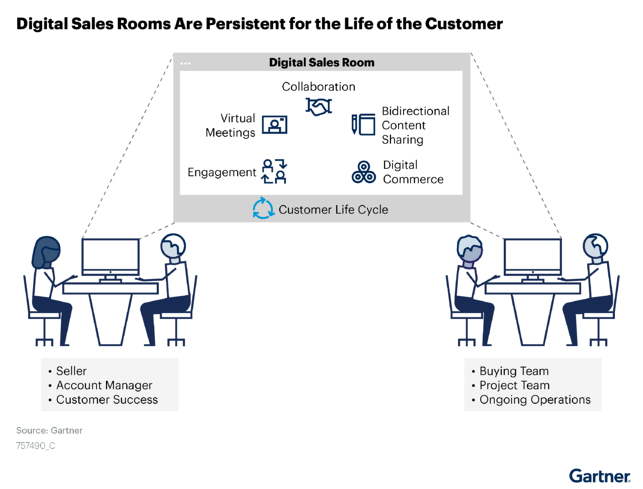“Show me, don’t tell me”—that’s the modern B2B sales cycle in a nutshell. Especially when it comes to software purchases, closing deals depends less on the salesperson making a charismatic pitch and more on their ability to provide prospects with robust marketing and sales collateral so they can make decisions autonomously. Most buyers undertake comprehensive research before talking to a sales rep. Data from market research firm FocusVision shows that buyers consume 13 pieces of content before making a purchase decision.
Salespeople must provide prospects with a steady stream of content in order to:
- Build brand awareness
- Educate buyers about the product
- Demonstrate why their company is the ideal vendor
- Address objections
- Provide pricing and contract information necessary to close the deal
Digital sales rooms enable sales reps to build repeatable processes for sharing custom content with their prospects throughout all stages of the buyer’s journey.
What is a digital sales room?
A digital sales room is a customer-facing content portal that has been personalized based on the customer’s needs and past behaviors. This can be in the form of a virtual showroom or simply a microsite. A microsite is a condensed version of the company’s website which exclusively contains content that has been hand-selected by the sales rep.
Sellers can create differentiated stories and personalized interactions that support buyers throughout their decision-making process. For example, if a prospect recently mentioned that they are also considering a rival vendor, a sales rep might include an infographic that provides a side-by-side comparison of their company’s product versus the competitor’s.
Digital sales rooms are made to promote a product, service, campaign, or event, or to target a certain buyer persona. They are commonly used as part of an account-based marketing strategy (marketing campaigns that are personalized for a specific client) to win big accounts.
Some companies use them to tell stories or experiment with new types of branded content. Microsites or digital sales rooms typically use a different domain or subdomain from the main company website and include links to the main website.
Why digital sales rooms are important
The typical B2B sales cycle is long—ranging anywhere from 0-9 months, depending on the annual contract value—and involves a multitude of stakeholders. This often means there is a long interval between lead generation—when prospects first express an interest in your product or service—and the sales discovery call. Only 19% of buyers want to connect with a salesperson during the awareness stage of the buying process. Still, a full 20% will only talk during the decision stage, once they’ve decided which product to buy.
Leads must be nurtured to keep them moving along the sales funnel. Digital sales rooms are also useful after a prospect’s initial contact with a sales rep as they aid in objection handling (60% of customers say no 4x before saying yes).
What are the components of a digital sales room?
Digital sales rooms are made for showcasing content designed to aid the buyer in their decision-making. This includes:
- Case studies
- Blog posts
- Testimonials
- White papers
- Proposals and pricing
- Personalized introduction videos
Content is cherry-picked specifically for the client. For example, the case studies might highlight clients in the target’s specific industry. Or the white papers might concern topics relating to pain points the target mentioned during an introductory sales call.

Digital sales rooms may also feature sales content to close a deal, including catalogs, pricing, mock contracts—even onboarding documents. This enables the client to access and share information with other decision-makers, communicate with their sales rep, and review and sign contracts from a single platform.
Companies can also use microsites to:
- Raise awareness for a specific cause
- Promote an event or product
- Highlight original research and gated content
- Nurture leads
- Target a specific client or client base
The best digital sales rooms provide a great customer-facing experience while enabling sales reps to monitor content consumption and communicate with prospects.
Microsite features to look out for:
- Guided product discovery – Provide personalized recommendations based on the prospect’s interests or prior browsing habits.
- Visual configurator – Allow your users to customize products using 2D or 3D visualizations.
- Document tracking and analytics – Get actionable insights on your content. How long do people watch your video before dropping off? Which stakeholders are disengaged?
- Sales collateral management – Build templates saved in a content library or upload pre-existing documents. Prospects can make comments and highlights on shared documents.
- Custom branded experiences – Take advantage of unique personalization elements that replicate the experience of in-person sales meetings.
- Real-time buyer communication – Provide live chat and video messaging functions so your prospects can contact you at any time.
- eSignatures and contract management – Make stakeholder approvals and contract sign-offs easy and seamless by hosting all documents in one place.
- Augmented and virtual reality – Provide an immersive visual buying experience that replicates the in-store experience and/or allows users to virtually try out products
What’s an example of a good microsite?
The best microsites focus on a specific value proposition. They feature an easy-to-follow structure that enables prospects to anticipate the next step of the sales process (eg: schedule a call with a sales rep or attend a webinar).
Here are some examples of compelling microsites designed to showcase original research or tell a story.
IKEA Life at Home
In the wake of COVID-19 lockdowns, IKEA published a report in 2021 featuring original research on the intersection of mental health and the living space. Through interactive features including map visualizations, videos, and responsive graphics, the report emphasizes the importance of having a comfortable living space and strong interpersonal relationships, which helps contextualize IKEA products.
Spotify: Listening Together
For its ‘Listening Together’ campaign, Spotify created a dedicated microsite to map the locations of Spotify listeners who press play on the same song at the same time, no matter where they are in the world. The site helps users discover new music on Spotify and creates a sense of community.
Lucidworks: The Data That Lies Beneath
This microsite by Lucidworks is about dark data—data that organizations collect but do not use for business purposes due to a lack of analytics capabilities. Companies only analyze 10% of the data they collect—which is likened to the iceberg effect (approximately ⅛ of an iceberg’s total mass is visible above water). This microsite tells a powerful story using imagery and statistics that leave a lasting impression.


